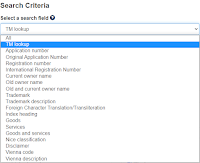By inspecting CIPO’s trademark XML data one may discover information that cannot be discovered by searching CIPO’s online trademark database, For example, the database’s Additional Search Options feature lets you choose one or more Category options:
As another example, suppose you want to look at marks for which a particular trademark agent is responsible, or marks for which a particular office of a multi-office trademark agency firm is responsible. You can’t do an agent-specific search of CIPO’s online trademark database. The agent-specific information is contained within the database, but CIPO doesn’t expose ‘agent’ as an available search field. The only fields you can search via the online database are the ones you see here (click the image to enlarge it):
By working with CIPO’s trademark XML data you can do agent-specific or agent-office specific searches.
Those are just two examples of many different types of information that can be obtained by working with CIPO’s trademark XML data to derive useful “business intelligence” such as:
- The extent of CIPO’s backlog of unexamined applications
- Trends, such as the average number of days taken to issue a 1st examiner’s report for applications filed over each of the past 10 years
- Significance of non-agent (pro se) filings, e.g. in comparison to filings by agents
- Monitor currently active opposition or Section 45 cancellation proceedings
- Review the most common word marks filed in Canada during any year or range of years
- Explore Canada-specific Vienna Classifications, e.g. “snowmobiles”, “cowgirls”, etc.
- and much more—click any of the tabs along the top of this page to see some examples (on a mobile device, use the dropdown menu to scroll through the examples and choose one).
This blog will discuss CIPO’s trademark XML data and the derivation of useful business intelligence from the data.



